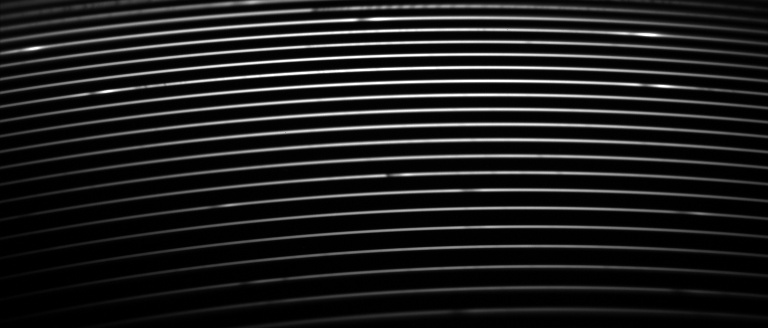
The
telescope interface. The guiding camera is a video Watek-120N. The
setup is very lightweight and easy to use. The spectrograph is located
at a distance of 10 meters.
FIRST LIGHT
OF AN ECHELLE SPECTROGRAPH
The page present my very first tests of a cross-dispersed spectrograph (April 2008). This moderate resolution échelle spectrograph was designed to allow stellar spectroscopy with resolution (R) from 5000 to 12000, depending on the brigthness of star and the scientific goals (the resolution is modified by changing collimator and/or camera lens).
The grating is an echelle model of 79 grooves/millimeter with a blaze angle of 63°. The spectrograph is equipped by a cross-dispersion prism (F2 glass) to separate spectral orders, so many differents are recorded in a single CCD exposure. The camera use standard photographic lens (nominaly a Canon 85 mm f:1.8 objective lens). The camera can be a CCD camera or a digital SLR (for education purpose - direct spectacular color spectra can be recorded).
The telescope and the spectrograph are linked by a 10-meters long fiber optics (50 microns diameter core). A special feature is used for center and focus the star image at the entrance of the fiber (the prototype is from F. Cochard - Sheliak instrument).
For the first light I use a CN-212 Takahashi telescope (D=0,2 m). I exploit the direct Newton beam of the telescope (F/4 focus).
|
|
|
|
Use of low cost digital camera (Canon EOS 40D)

True color echellogram of Vega
(Alpha Lyrae) taken with a Canon 40D camera (the red response is extended, see
here) and a Canon 85 mm f:1.8 lens. The measured resolution power is R=8
000.
The H-alpha line is the large absorption feature at the top. The H-beta
line is near the center.

Echellogram Delta Scorpius (it is a Be star). Note the evident emission of Balmer lines. Canon 40D, 9 x 300 s exposure with the 0,2 m telescope.

The calibrated spectrum of Vega (Canon
40D camera). I use orders from 33 to 38 only. I use a neon lamp for spectral
calibration
of this small part of the total acquired spectrum (a thorium lamp is pending...).
The
processing pipeline is fully automated (note the very good transition between
successive orders).

Calibrated
spectrum Delta
Sco (Canon 40D camera).

Calibrated spectrum Chi Oph (another
Be star). Modified Canon 40D - 9 x 300
s. The signal to noise ratio is fundamentally limited by
the fixed pattern noise
of the camera (CFA structure, and only one pixel sensitive for
4
available in the red - the processing quality can probably be improved in the
future). These documents
show that it is possible
to obtain very educational echelle spectra with a
relatively
modest camera.
Use of a black
and white CCD camera : Audine model equipped with a Kodak KAF-0402ME
(also
a low cost camera but with a modest sized detector - only a part of the echellogram
can be captured in one once)
100 mm focal length collimator and 85 mm focal
length camera configuration for a 8000 resolution.

Spica
(Alpha Vir), spectral type B1III (0,2 m telescope - 7 x 300 s exposure).

Sirius
(Alpha CMa), spectral type A1V (0,2 m telescope, 15 x 60 s).

Procyon
(Alpha CMi), spectral type F5IV-V
(0,2 m telescope, 4 x 180 s).

Delta
Sco (Be Star) - (0,2 m telescope, 5 x 300 s exposure).

48
Lib (Be star) (0,2 m telescope, 4 x 300 s exposure).

Chi
Oph (Be star) (0,2 m telescope, 4 x 300 exposure).
Use of a black
and white CCD camera : Audine model equipped with a Kodak KAF-0402ME
100
mm focal length collimator and 50 mm focal length camera configuration
for a 6000 resolution.

34
Boo (spectral type M3III) - 0,2 m telescope - 10 x 300 s exposure.

Arcturus
(spectral type K1.5III) - 0,2 m telescope - 12 x 60 s exposure.

Vega
(spectral type A0V) - 0,2 m telescope - 12 x 60 s exposure.

Delta
Sco (spectral type B0.3IV) - 0,2 m telescope - 5 x 300 s exposure.

Beta
Lyr - Sheliak (spectral type B7Ve) - 0,2 m telescope - 7 x
300 s exposure.

P
Cyg - 34 Cyg (spectral type B2pe) - 0,2 m telescope - 7 x
300 s exposure.

Nova
Cyg 2008 #2 (V2491 Cyg) the April 13.06, 2008 - 0,2 m telescope
- 14 x 300 s exposure. See details here.
And some corresponding
spectral profile...
(merge
of order 33 and 34, i.e. only 1/10 of the total available spectrum is show here
!)








Typical
acquisition session. Right, the guiding section: The cross mark the position
of nova Cygni 2008 #2 (at V=8.5) and indicate
precisely the entrance of the
optical fiber. Left, raw CCD image of the nova spectrum (5 minutes exposure).